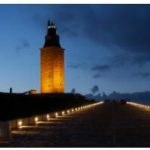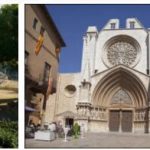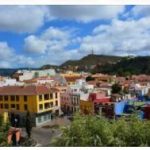Teide National Park (World Heritage)
The approximately 9000 hectare national park has a huge caldera 16 km in diameter. From it rises the 3718 m high volcano Teide, the highest mountain in Spain. The last eruption on the Teide massif took place in 1909.
Teide National Park: facts
| Official title: | Teide National Park (Tenerife) |
| Natural monument: | 1954 established nature reserve (190 km²) around the volcano Pico del Teide (3,718 m, highest mountain in Spain) in the center of the Canary Island Tenerife; spectacular, bizarre volcanic landscape with a cauldron-shaped collapse point (caldera) of 16 km; impressive visual effects through special light, air and weather conditions; Home to a multitude of endemic Canarian flora and fauna; third highest volcanic area on earth (7,500 m above sea floor) |
| Continent: | Europe |
| Country: | Spain |
| Location: | Santa Cruz (Tenerife) |
| Appointment: | 2007 |
| Meaning: | Unique high mountain volcanic ecosystem; exceptional opportunity to study geological processes in the formation of volcanic islands |
| Flora and fauna: | Endemic reptile species such as blue-throated lizard (Gallotia galloti galloti), gecko (Tarentola delalandii) and skink (Chalcides viridanus viridanus); 20 species of birds: a.o. Teide blue fink (Fringilla teydea teydea), island pipit (Anthus berthelotii berthelotii), monochrome swift (Apus unicolor unicolor), long-eared owl (Asio otus canariensis); five types of bats; 700 invertebrates (40% of which are endemic), including two-winged animals, beaked bugs; 168 species of higher plants, more than 50% of which are endemic; Teide gorse (Spartocytisus supranubius), Teide catnip (Nepeta teydea var. teydea), Tolpis (Tolpis webbii), red-flowered adder’s head (Echium wildpretii) |
Biscay Bridge (World Heritage)
This structure near Bilbao on the Bay of Biscay is a high bridge inaugurated in 1893 over the Nervión with a suspension ferry attached to it. It is still in operation today.
Vizcaya Bridge: facts
| Official title: | Biscay Bridge |
| Cultural monument: | In 1893 the suspension ferry bridge opened over the mouth of the Nervión River in the Basque Country; first-time transport of people and vehicles using a suspension bridge gondola; 45 m high and 160 m long steel construction with transporter bridge (approx. 14 x 10 m in size) for crossing the river without hindering shipping; Expansion in 1990 with a pedestrian crossing |
| Continent: | Europe |
| Country: | Spain |
| Location: | Portugalete, west of Bilbao, Basque Autonomous Country |
| Appointment: | 2006 |
| Meaning: | First bridge construction with transporter ferry worldwide; Masterpiece of steel construction from the 19th century; Pioneering work in traditional steel construction technology with the first use of twisted steel cables; outstanding aesthetic integration of an industrial building into an urban landscape |
Vizcaya Bridge: History
| February 12, 1890 | Building permit for the design by the engineer and architect Alberto Palacio |
| 1893 | Completion and inauguration of the transporter bridge |
| 1937 | Partial destruction during the Spanish Civil War to stop the advance of Franco’s troops |
| 1939 | Death of Alberto Palacio |
| 1941 | Reconstruction and resumption of ferry operations |
Úbeda and Baeza (World Heritage)
The northern Andalusian cities, about 10 km apart, are outstanding examples of Renaissance architecture. They go back to Moorish foundations and were redesigned from the 15th century. Renaissance palaces such as the Palace de Vázquez Molina in Úbeda are noteworthy.
Úbeda and Baeza: facts
| Official title: | Úbeda and Baeza |
| Cultural monument: | One of the Arab capitals on the Iberian Peninsula since the early 8th century (until the middle of the 12th century); Andalusian Renaissance small towns with urban design from the time of the Moors in the 9th century and after the Reconquista in the 13th century; in the 16th century; Remodeling based on the model of the Italian Renaissance; Buildings and squares in Úbeda including the former palace and today’s town hall Palacio de las Cadenas, Church of Santa Maria, Sacra Capilla del Salvador with two round towers, Plaza Vázquez de Molina, Hospital de Santiago; Buildings and squares in Baeza, including cathedral, Palacio de Jabalquinto, Plaza del Pópulo, Old University |
| Continent: | Europe |
| Country: | Spain |
| Location: | Úbeda and Baeza, southern Spain |
| Appointment: | 2003 |
| Meaning: | Outstanding examples of Spanish Renaissance architecture |
Úbeda and Baeza: history
| 9th century | Úbeda and Baeza as Moorish settlements |
| 15th century | Extensive construction work, including new buildings in the Italian Renaissance style |
Aranjuez (World Heritage)
According to philosophynearby, the cultural landscape of Aranjuez is a fertile area irrigated by the Tagus. For centuries it has been used as a growing area for fruit and vegetable plants, which are irrigated with canals in the Andalusian way. King Philip II had a summer residence built in this area in 1561, about 50 km from Madrid. The royal garden with its winding watercourses, statues and fountains is a highlight of garden art.
Aranjuez: facts
| Official title: | Aranjuez cultural landscape |
| Cultural monument: | Former summer residence of the Spanish kings on the banks of the Tagus; valuable interior and art collection; extensive gardens and parks from three centuries with winding watercourses, statues and fountains; inter alia: “Jardín de la Isla” from the time of Isabella I; Jardín de las Estatuas “by Philip II; “Jardín del Príncipe” with rococo castle “Casita del Labrador” by Charles IV; “Jardín de Isabell II.” |
| Continent: | Europe |
| Country: | Spain |
| Location: | Aranjuez, south of Madrid |
| Appointment: | 2001 |
| Meaning: | Outstanding example of landscaping carried out over centuries; Testimony to the amalgamation of different cultural and political influences from absolutism to the baroque to the enlightenment |
Aranjuez: history
| 1561 | Under Philip II, construction began on the royal palace based on designs by the court architect Juan Bautista de Toledo |
| 1567 | After de Toledo’s death, Juan de Herrera took over the planning |
| 1660/65 | Destruction of the plant by two major fires |
| 1727 | Reconstruction of the destroyed palace under Philip V |
| 1759-88 | The reign of Charles III, supporter of the Enlightenment |
| 1771-78 | Construction of the side wings of the Royal Palace |
| 1803 | Construction of the rococo castle Casita del Labrador |
| 1851 | Construction of the rail link to Madrid |









